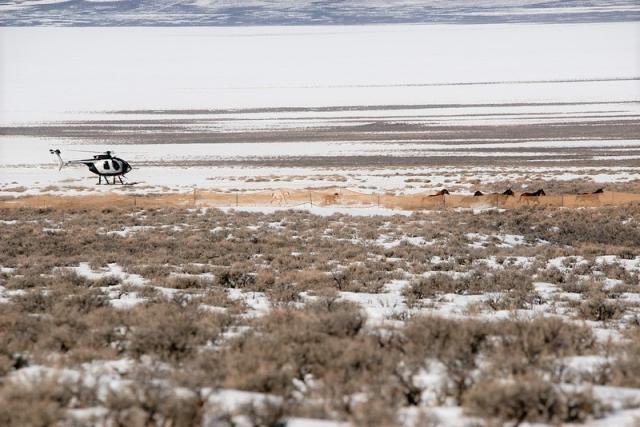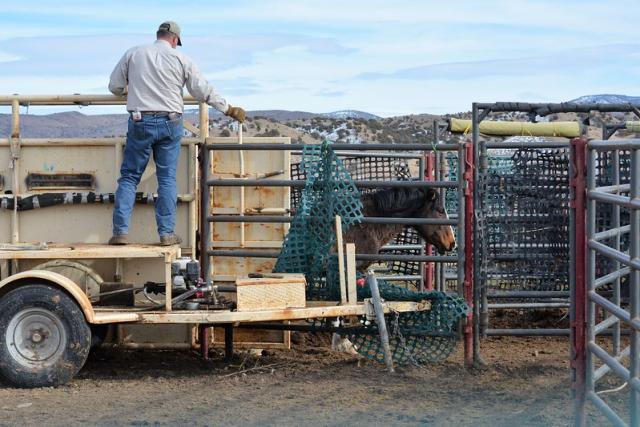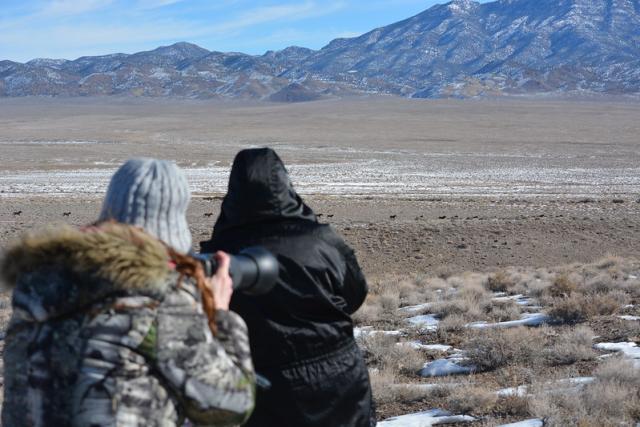You are viewing ARCHIVED content published online before January 20, 2025. Please note that this content is NOT UPDATED, and links may not work. Additionally, any previously issued diversity, equity, inclusion or gender-related guidance on this webpage should be considered rescinded. For current information, visit https://www.blm.gov/blog.
Numbers don’t lie: how the BLM safely gathers thousands of wild horses and burros every year
As part of the Bureau of Land Management’s commitment to the health and safety of the wild horses and burros under our management, agency personnel and contractors take extra caution when handling animals, including during helicopter-assisted gather operations. In addition, policies the BLM has put in place help underscore our commitment to safe and humane gathers for wild horses and burros. The proof can be found by just looking at the numbers.
BLM recently completed gather operations to reduce overpopulation within the Pancake Complex in Central Nevada, where forage and water resources have dwindled as herd population boomed and drought continues to intensify.

Of the 2,054 wild horses that were gathered from the Pancake Complex, five (0.24%) were lost due to an injury sustained as part of gather operations.
And earlier this year, just ten of 4,161 wild horses (also 0.24%) were lost due to gather operations that took place in Wyoming.
Of the total 16,883 animals gathered in Fiscal Year 2021 (October 2020 – September 2021), 25 animals (0.14%) were lost due to injuries sustained during a gather.
The BLM takes every injury seriously, and we work hard to prevent such accidents from occurring. At the same time, according to these data, severe injuries and deaths are exceedingly rare. This was reiterated by an external study conducted by the University of Wyoming.
The study, published in the Journal of Equine Veterinary Science, examined ten years of data and found that BLM's wild horse and burro helicopter-assisted gathers are much safer than similar gather operations (usually for scientific research projects) of elk, deer, and caribou, and just as safe as BLM’s other gather method (usually used for smaller gathers): traps stocked with bait such as food or water.
The study states that, in white tailed deer capture operations for example, between two and 20 deer die, out of every 100 deer captured. On the average wild horse helicopter gather, the data examined in the study showed fewer than one death from a capture-related injury out of every 200 wild horses captured.

In addition to the caution and experience of BLM and contractor personnel, part of the reason why BLM’s gathers are safer than other similar operations can be attributed to the policies we have put in place to protect animal welfare. When gathering wild horses and burros, the BLM and our contractors adhere to handling standards outlined in our Comprehensive Animal Welfare Program, which prioritizes the health and safety of the animals. The standards, which were developed in collaboration with animal welfare experts, help guide important aspects of gather operations, such as travel distance and speed, facility design, and foal care.
The required handling standards are observed at all stages of the gather. During a typical helicopter-assisted gather, a temporary corral is established to create a small trap. Wings made of a soft material called jute helps to funnel horses into the temporary corral. These locations are generally selected near established roads or trails that the horses are likely to follow naturally. The helicopter guides horses from a distance toward the trap area; horses are grouped together and slowly herded toward the trap at a pace the horses choose.
Once horses approach the wings, a domestic horse (referred to as a “Judas” or Prada horse) is released to encourage the wild horses to follow it into the trap. The helicopter will also drop in elevation and get only close enough to encourage the horses to continue to move toward the corral, never touching the animals. The wild horses often begin running at this point, which is also the point they typically come into view of any observers. This can lead to the impression the horses were “on the run” the whole time. Once the horses are in the corral, a gate is shut. The horses are then transported to a temporary holding corral.
So much of what we see and hear on social media can be misleading and give a false impression of what takes place during a gather. Some might infer that all reported deaths are as a direct result of injuries sustained during gather operations, while others may lead some to believe that gathers are dramatically violent: that simply isn’t the case. But don’t just take our word for it! The BLM is committed to transparency of our operations and welcomes the public and media to observe helicopter-assisted gathers from a safe location on public lands. Find a tentative schedule of upcoming gathers and make a plan to observe today!

Related Content
Related Stories
- Progress on Public Lands: BLM 2025 Trump Administration Accomplishments | January 20 - December 31, 2025
- Popular posts: BLM's most viewed blogs of 2025
- “Where did my horse come from?” BLM launches a new way for adopters, trainers and others to learn about their wild horses and burros
- Lake Havasu Fisheries Improvement Program is the gift that keeps giving
- BLM is thankful for public lands volunteers
